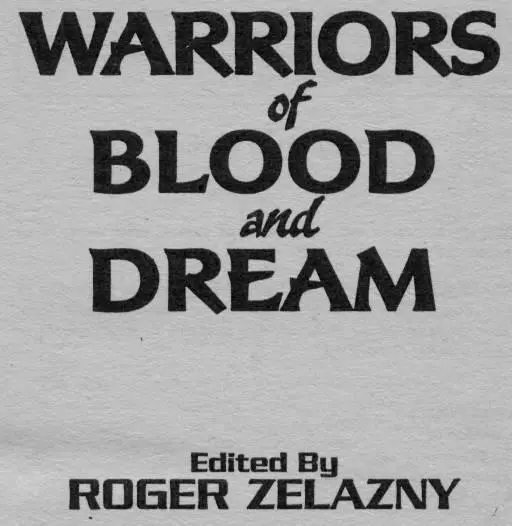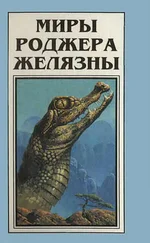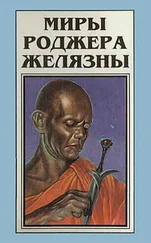Warriors of Blood and Dream


Copyright © 1995 by The Amber Corporation and Martin Greenberg
Cover art by Dorian Vallejo
ISBN: 0-380-77422-4
First AvoNova Printing: June 1995
Introduction
Roger Zelazny
A teacher affects eternity;
he can never tell where his influence stops.
—Henry Adams
1
In the only photo I have of Phil Cleverley he is throwing me to the ground with an effortless aikido technique which perfectly controlled my attack. He is somewhere in his mid-thirties. His shoulder-length hair is unmussed, his hakama draped, almost artistically, over hip, thigh, leg. My feet are high in the air; his expression is emotionless above his neat beard. The photo was taken by a passing photographer for the New Mexican , out early on a Saturday morning looking for human interest material.
It was a balmy spring day, sunny, with a bit of bird-song and a small breeze about us, as I recall. There had been some rain the night before but the ground was not wet, only a little damp. There would be a few grass stains on the gi . Nothing that a little bleach wouldn't remedy. Nobody else had shown up for class that morning in the park, and I was getting a private lesson. I think I had my brown belt at the time.
Phil taught a very soft style of aikido; that is, there were no jerks, wrenching movements, hard grabs—except from the person doing the attacking. There were times when I didn't even feel his touch, just felt myself suddenly off-balance, turning, falling. Not at all like the judo I had studied back in college. As effective, though.
I spent seven summers with Phil in that place, Patrick Smith Park, between Canyon Road and West Alameda, in Santa Fe, New Mexico. April through October, usually. Winters, Phil would rent space in a dojo, Kerry Li's or Cody Templeton's, where we would throw and be thrown on mats. He liked the grassy ground of the park best, however—often remarking that it was our real school—partly because one is seldom attacked for real when standing on a mat, partly because he was very fond of the outdoors. I never learned till the day of his funeral that he'd been an Eagle Scout as a kid.
Soft style. Hard style.... I remember Bill Gavel, a former Marine unarmed combat instructor, telling me in my earliest judo classes that when you are pulled you push, that when you are pushed you pull. He taught a lot of pure combat stuff, too, as opposed to the sport, things involving crushing larynxes, breaking necks and spines, and it all seemed good and useful, and the push-pull business really did work—after lots of practice. Later, Phil was to tell me that when you are pushed or pulled you turn. He was aware of the push-pull response as well, and when I questioned him upon the distinction he'd shrugged and said, "Not better. Not worse. Just different."
Phil had come to aikido with a background in Shoto-kan karate, kempo, and t'ai chi. One day when I was hunting for more distinctions he told me, "In karate when you block and counterpunch, you reject the attack, you reject the attacker. In aikido you embrace the attack, you embrace the attacker, and you turn."
"What's wrong with rejecting the attack and the attacker?" I'd asked.
He shook his head.
"Nothing," he said. "Neither way is right or wrong. They're just different approaches. Look at them as metaphors."
So, later, I did tae kwon do for six months, twice a week, on the side, to improve my attacks for aikido. It was not so much that I wanted the first, beginner's, belt in that art, but Phil's attacks—and those of the other people in the class who had done some form of karate—were so much cleaner than my own, that I felt a need to improve my attacking half of things. While it is true that aikido is mainly a defensive art, half of the time in class is spent being an attacker ( uke ), so as to give one's partner ( nage ) a chance to practice the defenses.
The concept of blocking and attacking was not totally unfamiliar to me. It had been there when I fenced for four years, as an undergraduate at Case Western Reserve (then just Western Reserve, as it didn't get together with Case till 1967), receiving varsity letters in the sport in my sophomore, junior, and senior years. I'd taken fencing in lieu of regular Phys Ed, as I couldn't stand team sports. Individual performance was something else, though. After the first year, the teacher had suggested I try out for the team, and I did. I wound up as captain of the épée squad in my final year, possibly by virtue of a certain double-jointedness which permitted my drawing my elbow back at an unnatural-seeming angle out of reach of riposte while going for a wrist touch. And parrying and attacking, beating a blade aside and attacking, is but an extended version of blocking and punching: Reject the attack, reject the attacker. Point!
Somewhere along the line, I learned the Japanese martial arts term for what I'd always sought in all affairs: suki . It means an opening. One can get all philosophical about yin and yang and mutual arisings, but basically it means that whatever you do you make yourself vulnerable somewhere. A skilled defensive player invites the attack and moves into the opening, the suki , which it creates. Even powerful, focused blows create their own suki , for strength is put forth in a wavelike pattern—exert, relax, exert, relax—and a soft-style martial artist will tell you that every moment of strength in the hard-style player's effort is followed by a moment of weakness. Avoid or parry the blow, and there is the suki . The soft stylist tries to avoid personal moments of strength and weakness himself by letting his strength flow at the same level at all times. No exertion, no lapse, enter the opening, embrace the attack, turn.
I am facing one of the pupils in the class I taught. I ask her for a munetski punch to my midsection. Initially, I face her squarely. As the attack commences I am moving forward and turning. If the punch connects, it does not matter. It will roll off of me in the course of the rotation. I apply the technique. I reverse my turning. She is on the ground .
Hard, soft, push-pull, reject-reject, circular-linear. None of this was unfamiliar, once I understood what the terms meant in practice. "The martial arts are a microcosm of the big world," Phil said. "It's all there."
"So what do you do if the person attacking you has studied silat or capoeira or some kung fu form you've never heard of?" I asked him.
"You can't learn them all," he told me. "I'll tell you one thing not to do, though: Never enter another man's universe, because in there he's God."
"What do you mean?"
"Don't try to play by his rules. He knows them better than you do. Try to make him enter your universe."
"How?"
"You might have to provoke his ki ."
"What do you mean?"
He gave me the finger.
End of Zen parable.
2
Winter, in the late fifties: The skies were ashen and sober and there were small ridges of snow at the curbsides on East 185th Street. It was a Friday. My parents always did the week's shopping on Fridays, in the stores that lined that thoroughfare. While they were about it I browsed the Woolworth's and Neisner's five-and-dimes, the one bookstore, and the drugstores' magazine racks. At one point, I waited for a break in the traffic and then hurried to cross the street. Partway over I struck a patch of ice and felt my feet go out from under me. I was pleased that I did a breakfall without thinking. My right arm struck the pavement at a forty-five-degree angle out from my body simultaneous with my turning my hip and spreading the force of the impact along the outside of my right leg just as my left foot made contact with the street. It was a good breakfall, and I picked myself up, brushed myself off, and continued on to the store I was headed for. I recall thinking, "At least I've gotten this much out of judo." I'd been doing it for a year or so then.
Читать дальше














